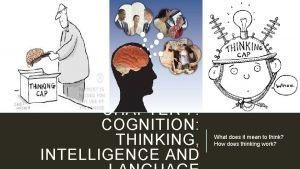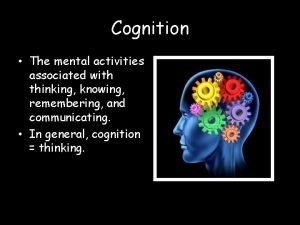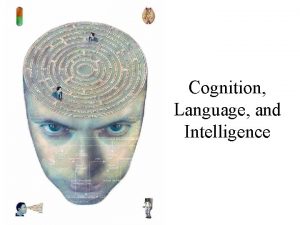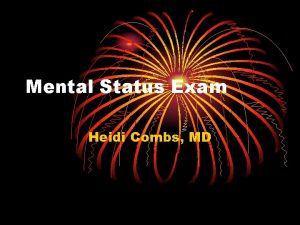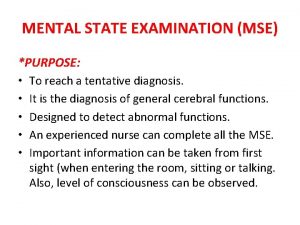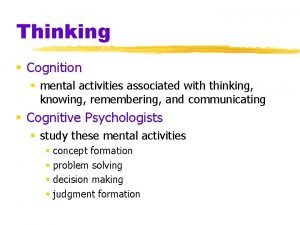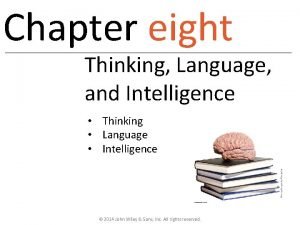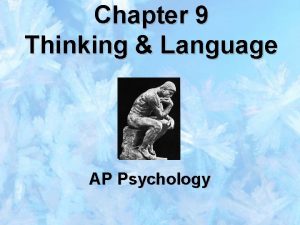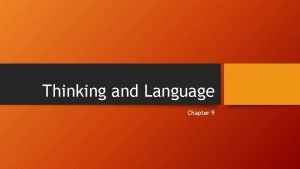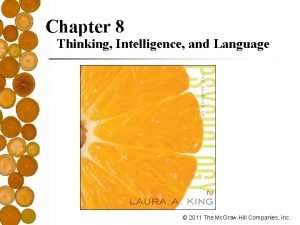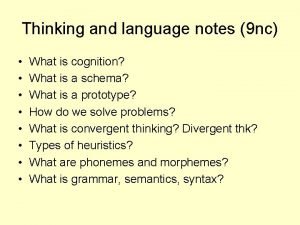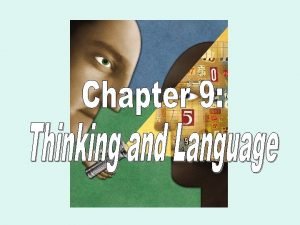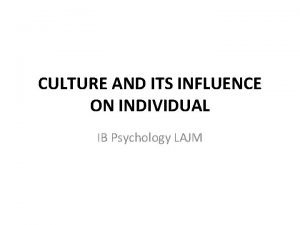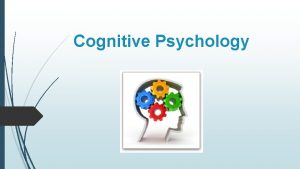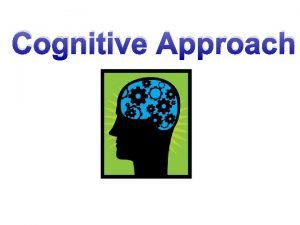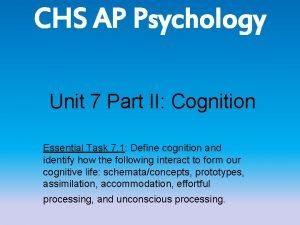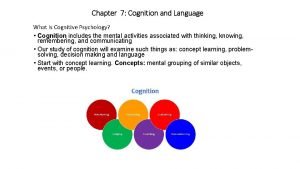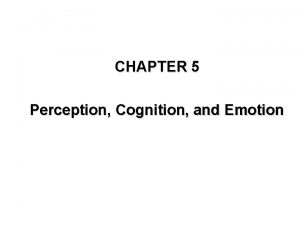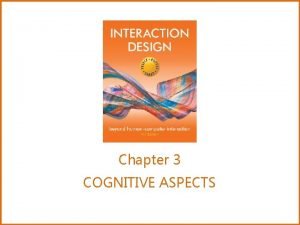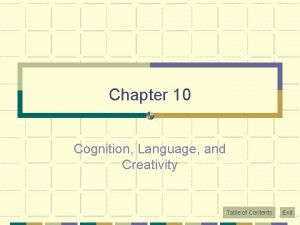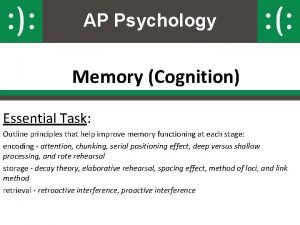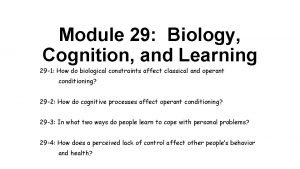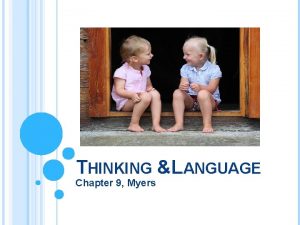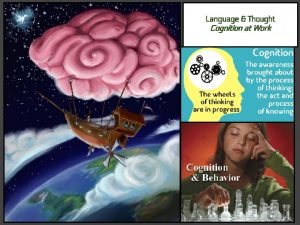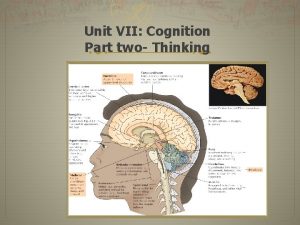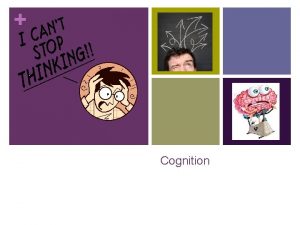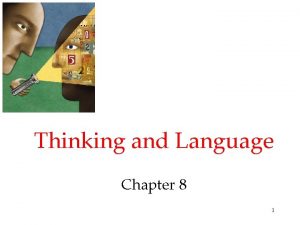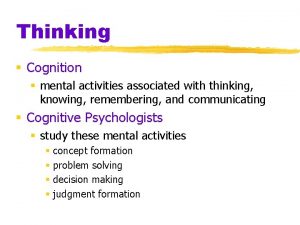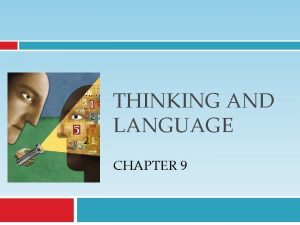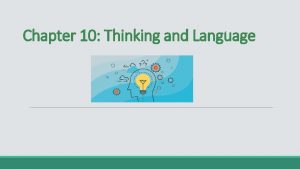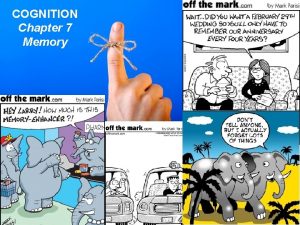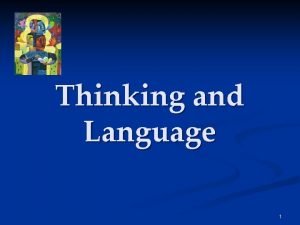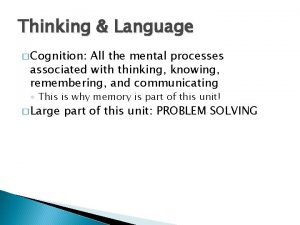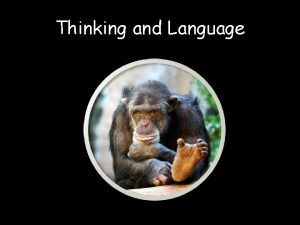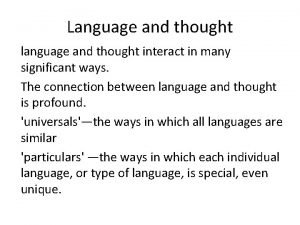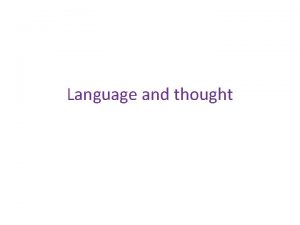Language Thought Chapter 11 Thinking Cognition the mental



































- Slides: 35

Language & Thought Chapter 11

Thinking • Cognition – the mental activities associated with thinking, knowing, remembering, and communicating

Concepts • Concepts – mental groupings of similar objects, events, ideas, and people in our world – Without Break down category Birds – concepts, couldn’t say happy or sad • Would have to describe facial expressions, body language, voice levels/tones, words, gestures…

Concepts • Prototypes – a mental image that incorporates all features we associate with a category. – Crow & ostrich

Solving Problems • Some problems are solved through trial and error • Algorithm – a methodical, logical rule that guarantees solving a particular problems – Long and usually suited to computers • Heuristic – thinking strategy that often allows us to make judgments and solve problems efficiently – Faster, but less accurate – Trial and error

Solving Problems • Insight – Unaware of problem solving technique used. Answer just comes to us – Occurs in right temporal lobe – Causes feelings of satisfaction

Jokes cause response similar to insight • ~ Tough Love vs. Spanking ~ (a psychological conundrum) It seems that these days most Americans think it is improper to spank children, so over the years I tried other methods to control my kids when they had one of "those moments. " One that I found effective is for me to just take the child for a car ride and talk. They usually calm down and stop misbehaving after our car ride together. This worked so well for my children that I now use the method on my grandchildren. I've included a photo below of one of my sessions with my grandson, in case you would like to use the technique. Sincerely, A Friend

Trouble with problem solving • Confirmation bias – A tendency to search for information that confirms one’s predictions – House? ? – We seek evidence to verify our ideas more often that seeking evidence to disprove out ideas

Confirmation Bias Example • Find the rule for this sequence of numbers 3, 5, 7 • Purchasing a pair of shoes, and then looking for the same pair of shoes at an expensive store to prove we got a bargain

Trouble continued… • Fixation – The inability to see a problem from a fresh perspective • Once you solve the problem incorrectly, it becomes difficult to reach correct answer – Mental set: tendency to approach a problem in a particular way that has been successful in the past » O –T-T-F-? -? -? » J-F-M-A-? -? -?

Trouble continued • Fixation – Functional fixedness: the tendency to think of things only in terms of their usual functions • Examples?

List other uses for these items:

Using & Misusing Heuristics • Representative heuristics – judging the likelihood of things in terms of how well they match prototypes – An Ivy League graduate with a degree in business – More likely to be a casino executive or a taxi driver?

Using and Misusing continued • Availability heuristic – when we base our judgments on their availability in one’s memory – If the come to mind quickly, we presume they are common • Remember most memorable – even it is not representative of entire population.

Overconfidence • Tendency to overestimate the accuracy of our knowledge & judgments – “I feel 98% confident that more than _____ percent but less than _______ percent of the US population owns a cell phone – Answer is 83% in 2007

Framing decisions • The way an issue is posed – Can affect decisions & judgments – 10 % of students in Geometry will fail versus 90% of students in Geometry will pass

Framing Example • When something is fat-free. . . what does that mean. . . It means that fat accounts for only 3% of the ice cream’s weight. In reality a four ounce serving accounts for 160 calories, of which 27 of them were contributed by FAT. MEANING that 27/160 ths of 17% of the ice cream’s calorie content. . . Read the fine print. . .

Another example Q: There are 1, 000 deaths by electrocution each year. How many do you think die from fireworks each year? estimate = 77 Q = There are 50, 000 deaths by car accidents each year. How many people do you think die from fireworks each year? Average = 331 Answer = SIX

LANGUAGE

Language structure • To learn a spoken language, we need three building blocks 1. Phonemes – set of basic sounds • English has about 40 2. Morpheme – smallest part of language that carries meaning • • Prefix and suffixes (re, pre, ing, ed) All words have at least 1 3. Grammar – rules for communicating and understanding

Language structure • Within grammar, you have – Semantics: the set of rules that allow us to derive meaning from morphemes, words, and sentence – Syntax: rules for putting words in order within a sentence “Colorless green thoughts sleep wildly” – this sentence has syntax but NO semantics

Levels of Language • Surface structure is the actual word string that one happens to use. • Deep structure is the basic meaning conveyed by the surface structure. i. e. The sentences “The girl threw the ball” and “The ball was thrown by the girl” have the same deep structure, but different surface structures.

Levels of Language continued • Producing language and understanding it are different cognitive acts. 1) Producing language requires going from deep structure to surface structure. 2) Understanding language requires going from surface structure to deep structure.

Learning Languages • Humans learn 3500 words a year (10 a day) • Receptive language – Babies’ ability to comprehend speech – By 4 months can distinguish sounds and read lips • Productive language – Babies’ ability to produce words

Learning a language • Babbling stage begins • By 10 months, at 4 months babbling begins to – Randomly utters sounds unrelated to the household language – NOT imitation of adult speech resemble household language

Learning Language • One-word stage – 12 months • Sounds now carry meaning • Child will speak in one word phrases • “Cat!” means look mom, the cat is eating the bird • Two-word stage – 24 months • Speech comes in two word phrases • Want juice, Get ball, play now

Skinner and language • Language learned through: – Association – Imitation – Reinforcement

Chomsky – inborn universal grammar • Children acquire language and grammar at a rate too fast to be taught – No parent teaches the phrase, “I hate you, ” yet kids will say it • Universal grammar – all languages have same building blocks (nouns, verbs, subject, direct object)

Chomsky – continued… • Children are equipped with a natural language acquisition box that allows them to develop language • Surface structure of a language – grasping of specific phonemes, morphemes, words and sentences and their combination rules that is developed over time – Vary from one language to another

Chomsky – continued…. • Statistical learning • Childhood is a critical period for language – Ability to detect speech patterns (syllable development breaks) – Spoken and signed • It becomes increasingly difficult to fully master languages not learned/developed during childhood

Linguistic determination • Psychologist Whorf asserted that language determines thought • Today it is agreed that it influences thought

Thinking in Images • Use procedural memory – Unconscious memory system for motor & cognitive skills & conditioned associations • Useful in practicing for upcoming events & can increase our skills

Skills shared by humans and Apes 1. 2. 3. 4. 5. Form concepts Display insight Use/create tools Transmit cultural innovations Have a theory in mind – reasoning, self-recognition, imitation, empathy, etc…


 Chapter 7 cognition thinking intelligence and language
Chapter 7 cognition thinking intelligence and language Chapter 7 quiz cognition thinking intelligence and language
Chapter 7 quiz cognition thinking intelligence and language The mental activities associated with thinking
The mental activities associated with thinking Cognition language and intelligence
Cognition language and intelligence An incomplete thought
An incomplete thought Chapter 20 mental health and mental illness
Chapter 20 mental health and mental illness Linear thought process mental status
Linear thought process mental status Mse summary
Mse summary Thought process examples
Thought process examples Jeopardy mental health
Jeopardy mental health All the mental activities associated with thinking
All the mental activities associated with thinking Positive thinking vs negative thinking examples
Positive thinking vs negative thinking examples Thinking about your own thinking
Thinking about your own thinking Holistic thinking example
Holistic thinking example Perbedaan critical thinking dan creative thinking
Perbedaan critical thinking dan creative thinking Thinking about you thinking about me
Thinking about you thinking about me When you group subcategories within broader concepts
When you group subcategories within broader concepts Chapter 9 thinking and language
Chapter 9 thinking and language Language
Language Chapter 8 thinking language and intelligence
Chapter 8 thinking language and intelligence Airline reservations typically decline after
Airline reservations typically decline after Belief perseverance
Belief perseverance Ideas of reference
Ideas of reference Loose thought process
Loose thought process Odden and rochat ib psychology
Odden and rochat ib psychology What is cognition
What is cognition Cognition definition
Cognition definition Embodied cognition ap psychology
Embodied cognition ap psychology What is cognition
What is cognition Types perception
Types perception Altered cognition in older adults is commonly attributed to
Altered cognition in older adults is commonly attributed to What is cognition
What is cognition Cognition definition
Cognition definition Priming memory examples
Priming memory examples Unit 7 cognition ap psychology
Unit 7 cognition ap psychology Module 29 biology cognition and learning
Module 29 biology cognition and learning

